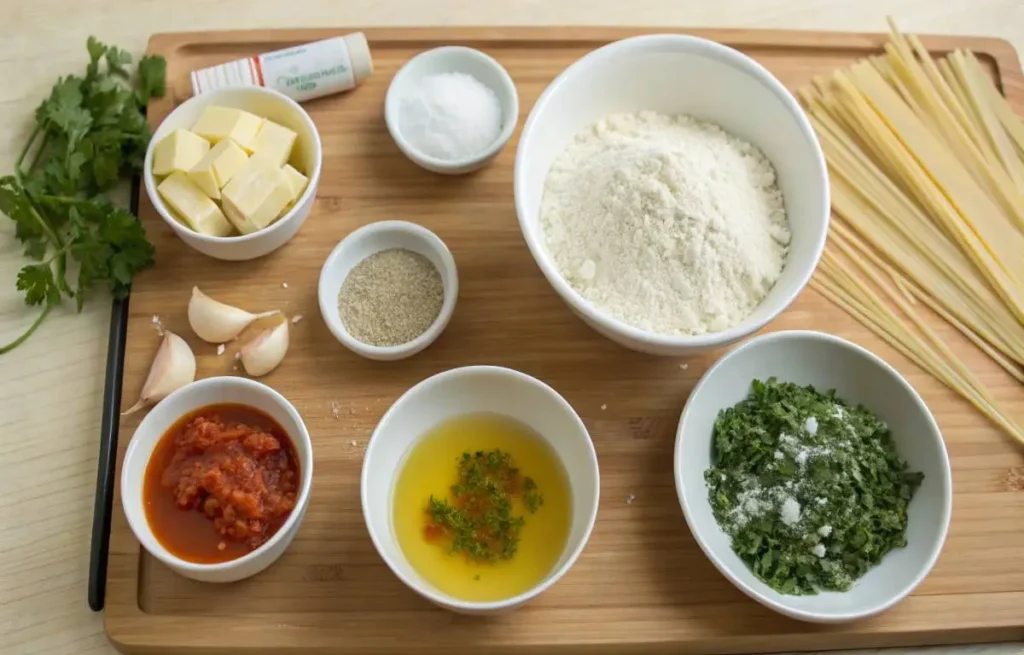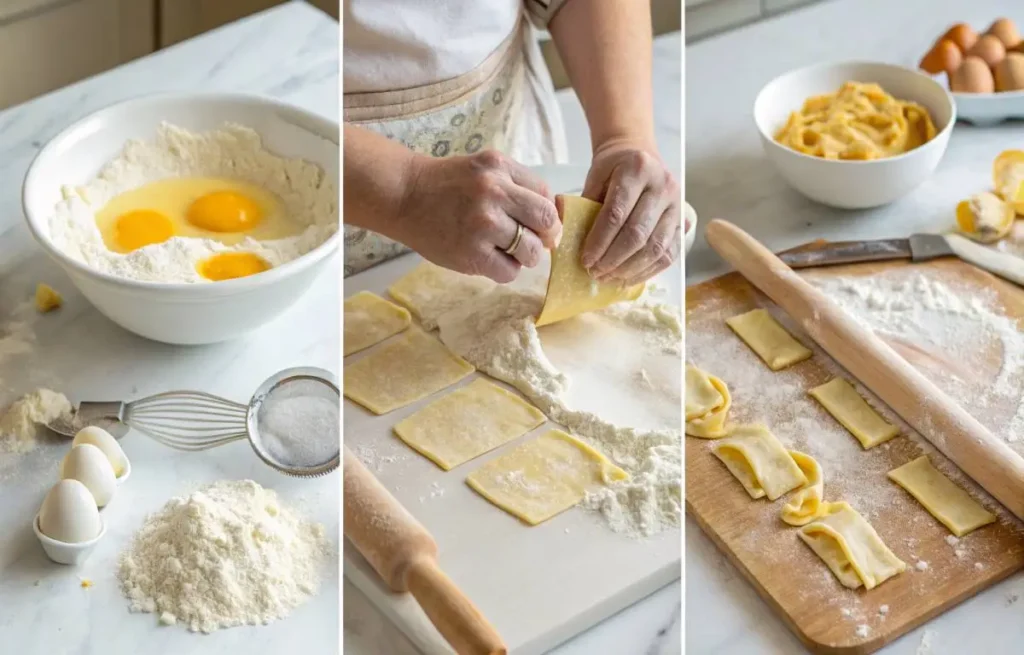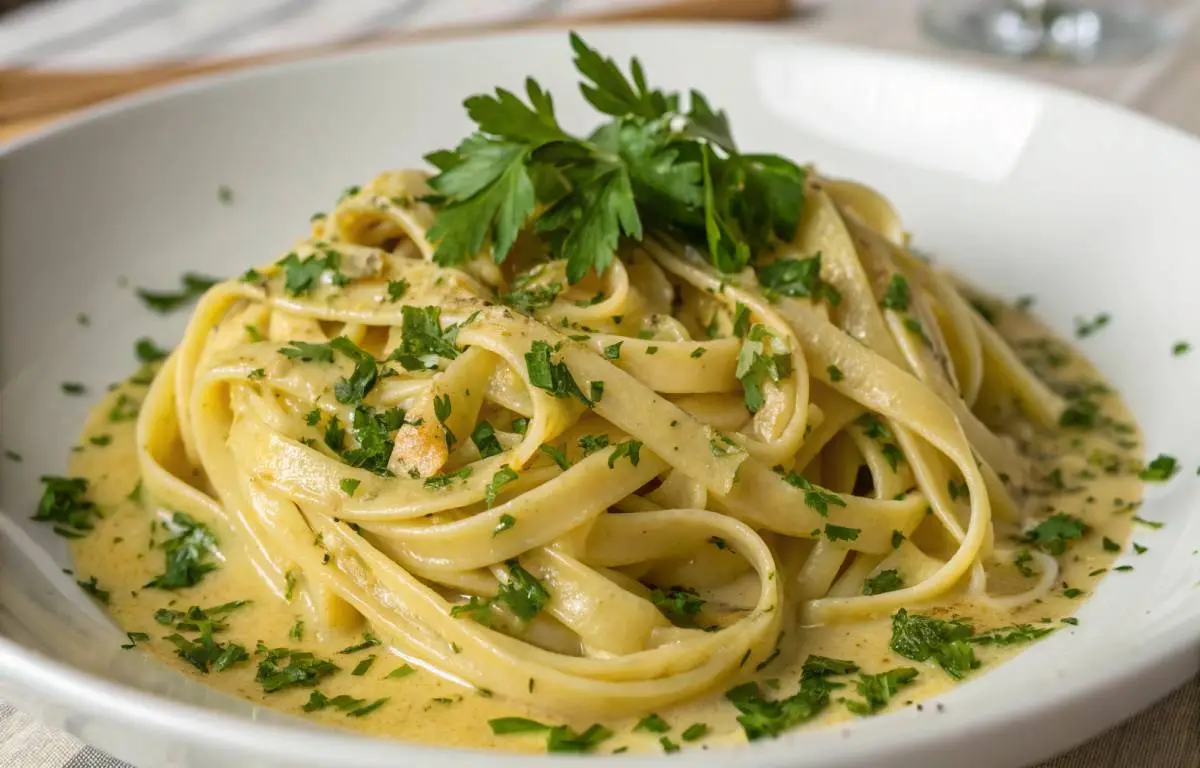Whipping up fresh pasta at home sounds like a big deal, but trust me, it’s way easier than it looks, and the payoff’s instant. I tried it for a date night last month, and it turned my kitchen into a little slice of Italy—total game-changer. If you’ve been thinking homemade pasta’s too fussy or takes forever, this recipe’s gonna flip that script. It’s all about keeping it simple and soaking up the fun of rolling dough, even if my first batch was a bit lumpy. Get ready to make your next dinner feel special, no chef skills required!
Ingredients list

For the Fresh Pasta Dough
- 2 cups (240g) all-purpose flour (or 00 flour if available)
- 3 large eggs, at room temperature
- 1 tablespoon olive oil
- A pinch of salt
For the Sauce (Simple Garlic Butter Sauce)
- 4 tablespoons unsalted butter
- 2 cloves garlic, minced
- Fresh parsley, chopped (optional)
- Salt and freshly ground black pepper to taste
- Grated Parmesan cheese for serving
Substitution Ideas
No all-purpose flour? No sweat—grab semolina flour or mix it with all-purpose for a chewier, more textured pasta. I tried semolina once, and it gave my noodles this awesome, firm bite, like something straight out of an Italian nonna’s kitchen. Going vegan? Swap each egg for ¼ cup water mixed with a tablespoon of olive oil—works fine, though the flavor’s a bit different, and mine came out a tad gummy. For a lighter sauce, ditch the butter for olive oil, and if parsley’s not your thing, toss in basil or thyme for a fun twist. I swapped Parmesan for Pecorino Romano last week for a saltier kick, and it was almost too good. Play around, and you’ll still end up with a killer pasta dish!
Timing (prep, cook, total, passive)
- Prep time: 15 minutes
- Resting time: 30 minutes (passive)
- Cooking time: 3–5 minutes
- Total time: Approximately 50 minutes
Resting the dough is essential to let the gluten relax, which makes rolling out easier. While it’s tempting to skip this, patience pays off in better texture.
Step-by-step detailed instructions for Pasta Fresca Recipe

- Prepare the Dough: Start by piling your flour on a clean counter and digging a little well in the middle. Crack those eggs in, splash in some olive oil and a pinch of salt. I tried this last week and got eggshell in the mix—oops. Grab a fork and whisk the eggs gently, pulling in flour bit by bit until you’ve got a shaggy dough that’s ready to knead.
- Knead the Dough: Now get your hands in there and knead, pushing the dough out and folding it back. It’s a workout—takes about 8–10 minutes ‘til it’s smooth and stretchy. My first go was sticky as heck, so I sprinkled more flour. Too dry? Wet your hands and keep going. It’s forgiving, trust me.
- Rest the Dough: Wrap that dough in plastic or tuck it under a damp cloth for a 30-minute nap at room temp. This is key—I skipped it once, and rolling was a nightmare. It’s like letting the dough chill out so it’s easier to shape later.
- Roll Out the Dough: Split the dough in two. Grab a rolling pin—or a pasta machine if you’re fancy—and roll each piece super thin, like 1/16 inch. I don’t have a machine, so I’m all about elbow grease. Flour the surface lightly to avoid sticking, and keep at it ‘til it’s nice and thin.
- Cut the Pasta: Now cut it into your favorite shape. Fettuccine or tagliatelle’s perfect for a cozy date night vibe—I went with tagliatelle and felt like a chef. Use a sharp knife or pasta cutter for ¼-inch strips. Mine were a bit uneven, but it’s all good.
- Cook the Pasta: Get a big pot of salted water boiling. Toss in the fresh pasta and cook for just 2–3 minutes—it’s way faster than dried stuff. Keep an eye on it; I overcooked mine once, and it was mush city. You want it tender with a little bite.
- Prepare the Sauce: While the pasta’s cooking, melt some butter in a pan over medium heat. Throw in minced garlic and sauté for a minute—don’t let it brown, or it’s bitter. I learned that the hard way. Take it off the heat when it smells amazing.
- Combine and Serve: Drain the pasta quick and toss it right into that garlicky butter. Stir gently to coat, then season with salt, pepper, and a handful of chopped parsley. Top with fresh Parmesan—I grated too much last time, but who cares? It’s a plate of cozy, homemade heaven.
Tip: Save some pasta water before draining to loosen the sauce if needed.
Nutritional Info
A serving of this pasta fresca recipe (approximately 1 cup cooked) contains about:
- Calories: 320
- Carbohydrates: 45g
- Protein: 12g
- Fat: 8g
- Fiber: 2g
There’s something comforting about how simple the ingredients are in fresh pasta dough. The carbs give you that steady energy boost, and the eggs sneak in a bit of protein to balance things out. Add butter to the sauce, and you’ve got a rich, velvety texture along with healthy fats that actually help your body absorb more nutrients. Sure, it’s not exactly a light meal—but it is made from real, whole ingredients, which makes it feel hearty and worth every bite.
Healthier Alternatives
If you’re trying to make this pasta fresca a bit healthier, you’ve got a few easy options. Swap the regular flour for something like whole wheat or even spelt—it adds more fiber and gives the dough a nice, slightly hearty taste. Instead of using butter, try olive oil. It’s better for your heart and still gives the sauce that rich, silky texture. Throw in some veggies too—spinach, zucchini, whatever you’ve got on hand—just to add some color and extra nutrients. And yeah, you can cut back on the cheese a little or use a lighter one, but honestly, a little Parmesan goes a long way. It won’t taste exactly the same, but it’ll still hit the spot, and your body will thank you for it.
Serving Suggestions
This fresh pasta really shines next to something simple—like a crisp green salad tossed with lemon juice and good olive oil. If you’re making it for date night, pour a chilled glass of Pinot Grigio or maybe even a light Chianti. Both go surprisingly well with the butter and garlic without overpowering anything.
Want to make it feel a bit fancier? Add a few seared scallops or slices of grilled chicken on the side. Or, if you’re keeping it vegetarian, try roasting some cherry tomatoes with a little salt and olive oil until they burst—toss in fresh basil, and you’ve got the perfect sweet-acidic bite to balance the richness of the pasta.
Common Mistakes to Avoid
- Don’t skip the resting: I get it, waiting isn’t fun, but letting your dough rest makes it way easier to roll out and keeps it from shrinking when you cook it. Trust me, it’s worth the wait.
- Roll thin and even: Thick or uneven dough means uneven cooking. Take your time and aim for thin sheets—you’ll notice the difference in every bite.
- Watch the clock: Fresh pasta cooks fast—like, 2 to 3 minutes fast. Overcook it, and you’ll end up with mushy noodles nobody wants to eat.
- Don’t go crazy with the flour: Use just enough to stop sticking. Too much flour dries the dough and messes with the texture.
- Salt that water: This one’s easy to forget, but salting your boiling water is key to good flavor. Your pasta will thank you.
Storing Tips
Fresh pasta tastes best right after you make it, but if you need to save some for later, here’s how to keep it fresh. Lightly dust the pasta with flour so it doesn’t stick together, then spread it out flat on a baking sheet or hang it on a drying rack. Cover it loosely with a clean towel and pop it in the fridge for up to a day.
If you want to store it longer, freezing works great. Lay the pasta in a single layer on a baking sheet, freeze until it’s firm, then move it to airtight bags. When you’re ready to cook, just drop it in boiling water straight from the freezer—give it an extra minute or two to cook through.
Conclusion
Making fresh pasta from scratch is about way more than just the meal. It’s about the laughs, the little messes, and that awesome feeling of crafting something homemade. This recipe has turned many regular evenings into something memorable—just by taking your time and enjoying the whole process.
Have you ever made fresh pasta for a special occasion? How did it go? I’d love to hear your stories or any tips you’ve got—share them below so we can all learn a thing or two!
People Also Read
Chicken Crust Pizza Recipe They Beg Me to Make
FAQs
Q: Can I use a food processor to make the dough?
A: Yes, a food processor can mix the dough quickly, but kneading by hand helps develop better texture. Either method works if you rest the dough properly.
Q: How do I know when the pasta dough is ready?
A: The dough should be smooth, elastic, and slightly tacky but not sticky. If it cracks when rolled, it needs more kneading or moisture.
Q: Can I make this pasta fresca recipe gluten-free?
A: Gluten-free pasta dough requires different flours and binders like xanthan gum. This recipe won’t work as-is, but there are gluten-free pasta recipes available.
Q: What if I don’t have a pasta machine?
A: Rolling by hand works fine, just requires more effort. Use a rolling pin and patience to get thin sheets.
Q: How long can I keep fresh pasta in the fridge?
A: Ideally, consume within 24 hours for best taste and texture. Longer storage can lead to drying out or spoilage.

